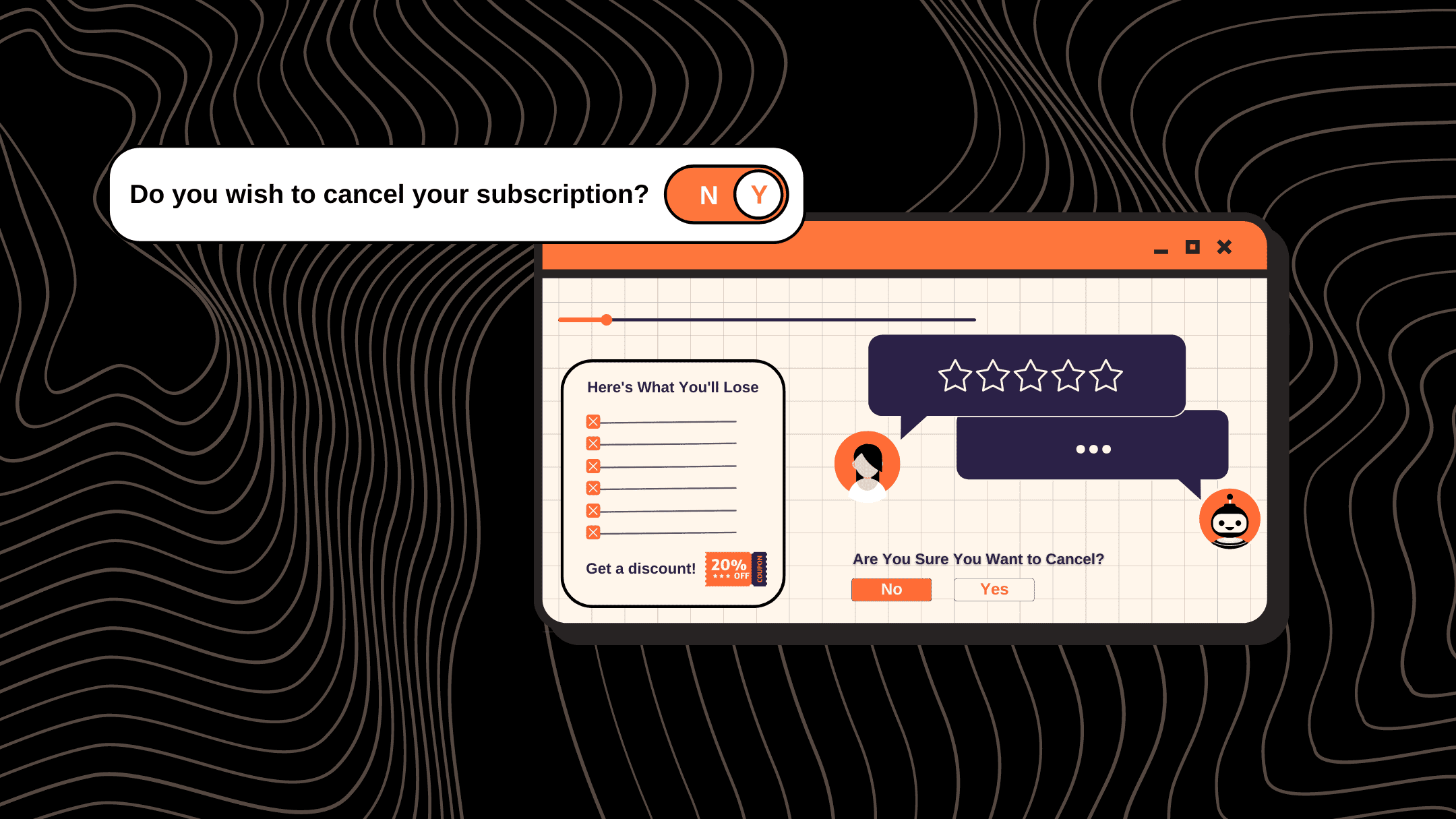Most businesses treat customer cancellation surveys as a means to collect terminal customer feedback, without realizing how important it is in supporting your retention engine at the moment of cancellation. Sure, the analytics is a great assist against possible future churn. But, there are more immediate impacts that often go undetected, and hence, underutilized.
More importantly, it has a significant impact on your strategic and product roadmap and gets you closer to realizing your revenue targets. Don’t believe me yet? Read on –
At 120,000+ customers, AI-led landing page builder Unbounce was significantly sized to experience ‘growth pains.’ A good part of it came from the churned revenue, not particularly helped by a static cancellation survey which did nothing beyond collecting customer information and storing it in a database.
To unlock retention growth, something had to change. Unbounce decided that it had to be their retention engine. They partnered with Chargebee Retention to build a dynamic cancellation survey. One that would not only collect terminal customer feedback but would also use that feedback to power personalized retention offers so customers were more compelled to stay.
The result generated undeniable merits –
“Now we understand that when a customer hits cancel, they’re raising their hand for a lifeline. With Chargebee Retention, we’re able to deflect 11% of cancellations by being there for our customers when that hand goes up.”
– Max Tims, Unbounce’s (former) Director of Revenue Ops and Strategy
The lessons are pretty clear. If you want to reduce customer churn, it’s important to find out common customer objections, and use them as ammo in your retention arsenal. Not only by building a better understanding of why your customers are leaving but by using those reasons to actively define how you will continue to keep them on board.
In the upcoming sections, we’ll explain how you can design an effective cancellation survey. But before that, let’s touch upon the basics.
What is a cancellation survey?
A cancellation survey (also known as a churn/exit survey) is a questionnaire aimed at gauging customer satisfaction and the net promoter score, imploring the user to share additional details about why they are looking to unsubscribe. It is, therefore, not only a means for net promoter score (NPS) tracking, it is also a means to minimize guesstimates when building the perfect product experience by collecting actionable insights, and identifying feedback/concerns directly from customers.
Most business – subscription or not, online or offline – uses surveys to understand their audience better and reduce customer churn. However, not everyone does it right.
Businesses vary on how they present/deliver a cancellation survey to customers with a churn intent. Some may choose to present it as a pop-up form on cancel pages, others may retroactively send this to churned customers via email, text message, and even as a separate online link.
Our recommendation here is to have your customers fill-up the cancellation survey while they are still in the process of canceling their subscription. This reduces the risk of non-responsiveness, and since you already know why they are canceling, helps you present personalized offers based on their inputs to drive a last attempt at retaining them.
Beyond only collecting data around churn intent, cancellation surveys are also a leading indicator of a few critical symptoms of impending churn. These include –
- Low product/service adoption by customers
- Cart abandonment or incomplete purchases/subscription flows
- High LTV-customer churn patterns
- Non-performing retention offers
One has to be mindful of the fact that churn is not an event but a process. Deficiencies at any stage of their journey with your business can become the triggering event. A thorough understanding of customer satisfaction or their unique experience with your product across all stages through feedback surveys will help you glean useful information. And with that knowledge, you can implement the right strategies to address any customer concerns.
How to build a cancellation survey
Using Google Forms or having your developers build an online form to document user responses is perhaps the most inexpensive way to build a cancellation survey. However, form-based cancellations surveys are both unscalable (i.e. cannot grow or incorporate advanced use cases and features) and are inefficient in supporting your retention efforts (i.e. cannot actively fuel your retention offers at the point of cancellation).
Having worked as the central retention engine for subscription businesses of all sizes, we have witnessed first-hand how a competent, scalable cancellation survey system can generate manifold returns on the initial investment cost.
The following are a few components of building an effective cancellation survey. To avoid making the cancellation survey onerous, you can choose only the components that make the most sense to you and ignore the ones that don’t:
- A short, form-based questionnaire
- An offer presentation module
- A key benefits reminder module
- An analytics module (this is compulsory)
- A data storage module (again, compulsory)
- A deflection module, and
- A cancel/proceed button
The following example from pliability – the human mobility platform, is a great example of how brands can use a congregation of the multiple components in a cancellation survey effectively.
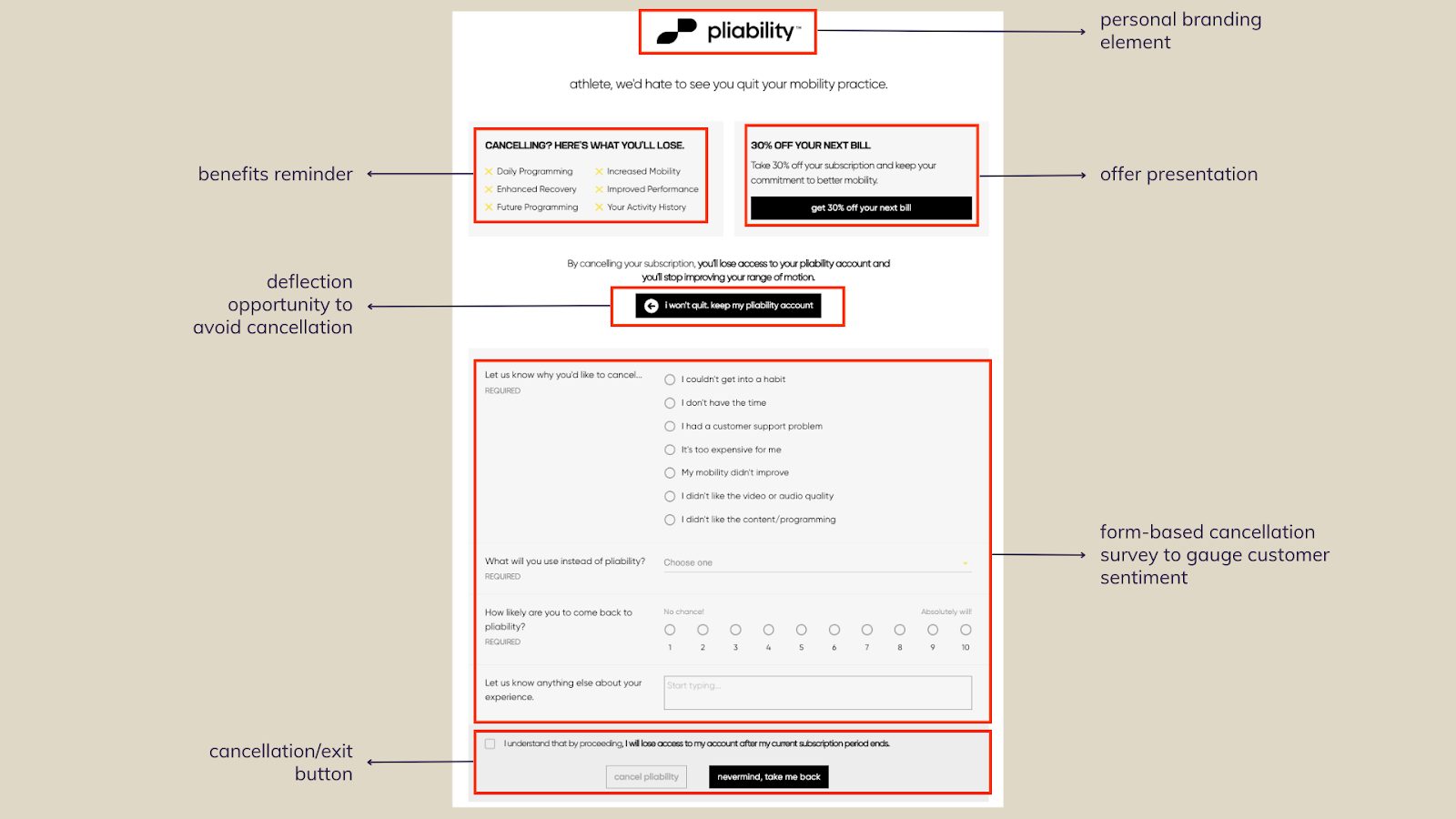
This is a standard example of a static cancellation survey, wherein, the survey is conducted at the point of offer presentation, and just before the customer leaves.
It is a simple setup within Chargebee Retention, integrates with any existing subscription management and billing system, and arrests critical data to optimize efforts and arrest future churn.
For pliability, feedback captured at the point of cancellation, helped them realize a few critical details that would go on to help them move the needle on user experiences:
- First, they realized that many customers were canceling their subscriptions because they didn’t have enough time to maintain a daily regime. pliability moved on to make their shorter modules more accessible, directly reducing churn by over 20% in a year.
- Secondly, they realized the impact their in-app music offering had on their customer experience and further developed that feature.
The other more dynamic methodology, one that Unbounce applies, is to collect customer feedback prior to the offer presentation stage, then send the user to a specific landing page depending on what they determine is their primary cancellation reason.
The key, in both cases, is also to ensure that data collected from the cancellation survey is accessible to your business teams so they can make strategic decisions on the way ahead. This helps businesses take data-led decisions and minimize the guesswork.
However, the most rudimentary of expectations from a cancellation survey is that it will solicit feedback from your customers. Its endgame, just like any of your landing pages or websites is to drive conversions. Therefore (and while it may not look like it), building a cancellation survey employs a significant degree of design thinking.
Longer customer surveys are known to have a very high drop-off rate. According to Survey Monkey research, when customers had to spend more than 7 to 8 minutes on a survey, the survey completion rates dropped by almost 5-20%.
If your cancellation survey is riddled with questions, the customer would naturally want to get through them as quickly as possible. This also impacts the accuracy of answers, and in the worst cases – may lead to misleading responses. Here are some examples of how other companies maintain the balance between an exhaustive survey and a quick time-to-value for customers.
A few examples of how businesses present their cancellation survey
Netflix’s “cancellation survey page” minimizes the need for the customer to fill multiple form fields. Upon cancellation, users are taken to a confirmation page, where they are smartly given the option to downgrade to a cheaper plan in an attempt to deflect a canceling customer.
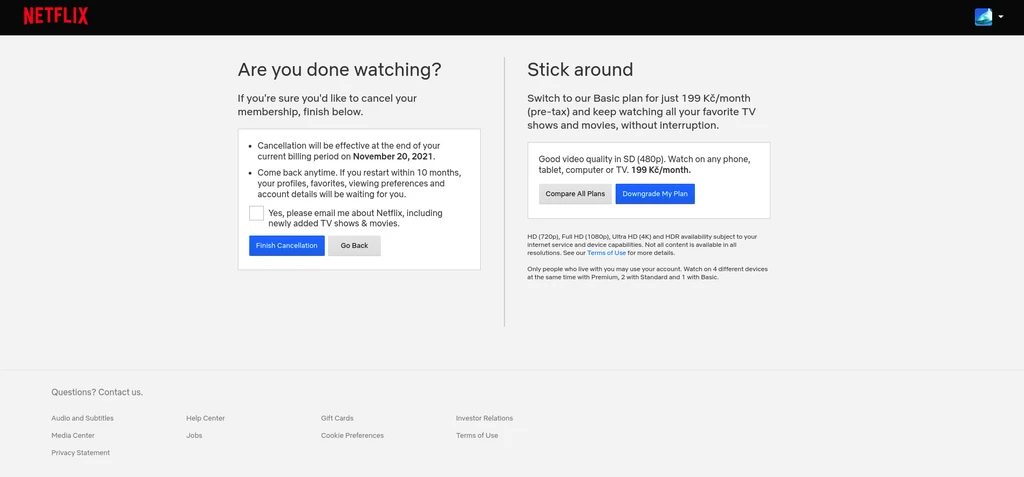
After confirmation of their cancellation intent, the customer is taken to the cancellation survey with a single question about their reason for cancellation. No long-drawn forms, no intrusive details. Simple, easy cancellation experience.
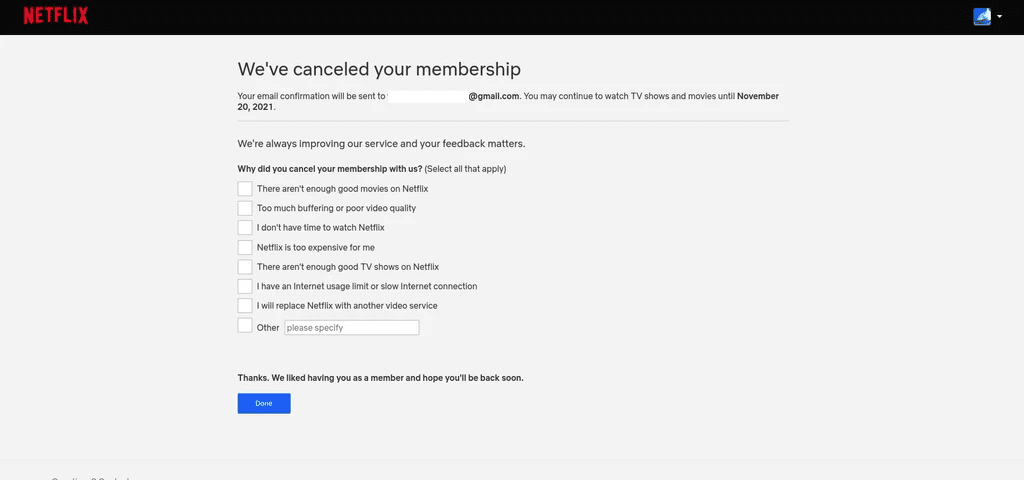
This is another example of a cancellation survey template from TouchNote, a subscription-based card-sending service.
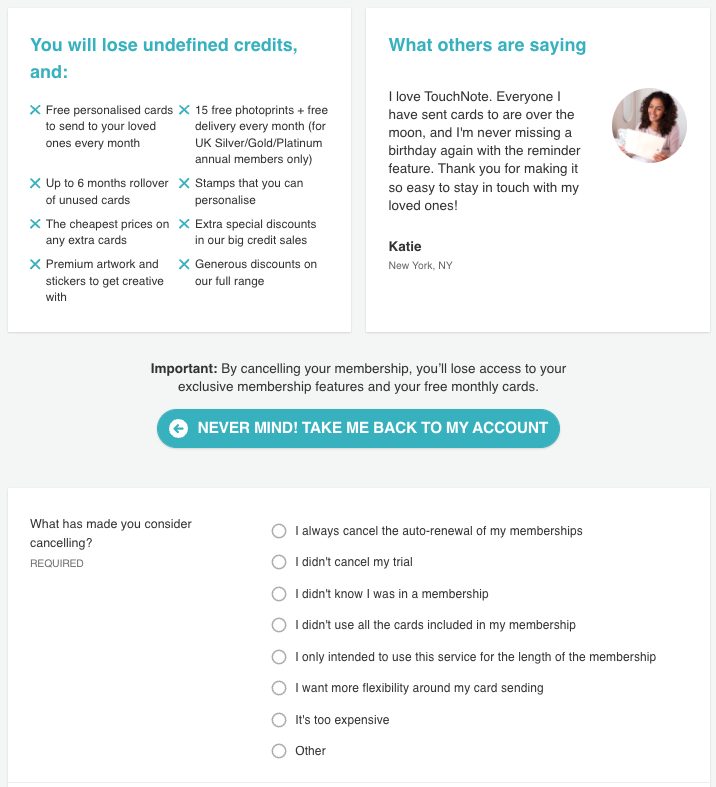
The question has been designed in a way that doesn’t require much effort on the part of the customer. Also, notice how this survey gives the customers a chance to reconsider their decision. It explains all the great features of the platform they would end up missing out on by canceling the subscription.
The best part about TouchNote’s retention experience is even beyond the cancellation survey, the platform experimented with multiple retention experiments which included testing multiple discount ranges, and the options to pause/skip subscriptions. The results – a 56% increase in save rate in less than 12 months.
The cancellation survey form template from Delighted (an experience management platform) is a little different. They use an open-ended question format, which opens up the possibility of having a dialogue with the customer. You can consider this as a customer cancellation interview. The long-answer field allows customers to be as personal and candid as they would prefer, and might uncover information otherwise overlooked from generic dropdown fields.
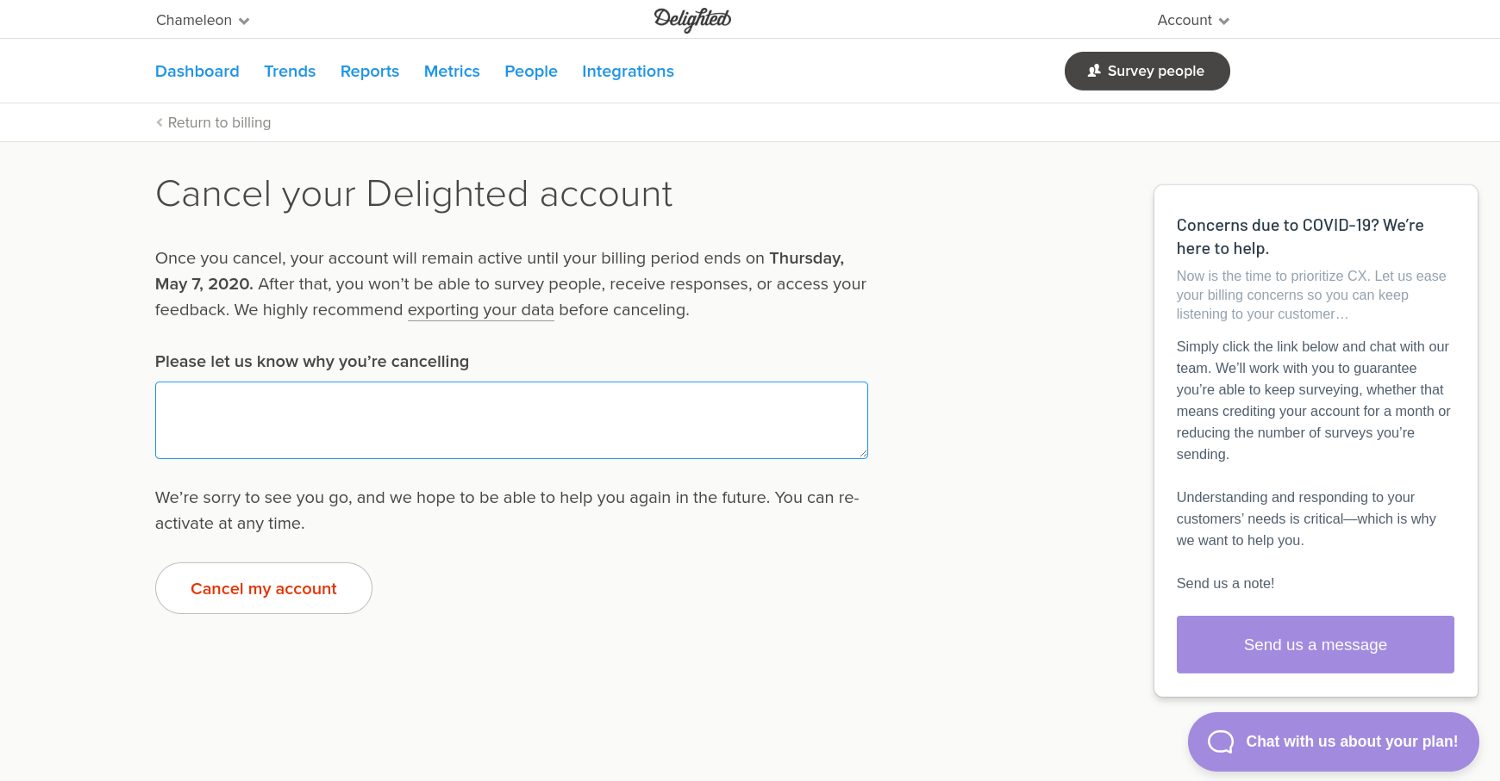
Customer cancellation survey v/s long-form customer interview: Whether you want (or don’t) to have long-form answer fields, depends on the outcomes you want from your cancellation experiences. No one technique is better than the other. While a long-form exit survey interview will provide you with more comprehensive answers, a straightforward and objective option-based survey will be easier for the customer to fill out.
5 Must-have questions in your cancellation survey
The right cancellation survey questions can make all the difference in getting you a higher response rate. Here are some questions you can decide to include in your cancellation survey but be mindful of keeping it short.
Question #1: How often do you use the product?
For this question, you can again create a list of options like ‘once a week’, ‘daily’, or ‘once a month’. With this, you can find out the level of value customers are deriving from your product.
Question #2: What made you cancel the subscription?
This is the most important and also the most commonly used cancellation survey question. You can provide a list of options, or let the customer elaborate on the answer. The responses obtained to this question can be useful for making any improvements to your product or site.
Question #3: What did you enjoy about [product name]?
Asking this question will help you understand the perceived plus points of your product. But make sure to include a skip option with this, since some customers might not be inclined to answer this when they’re canceling their subscription.
Question #4: What is something we could have done to prevent you from leaving?
Give your customer a chance to offer the solution to the particular problem they were facing. This is another question that can be very useful for reducing customer churn in the long run.
Question #5: Would you use our service again?
Take the opportunity to find out if your customers would be willing to return in the future. This is also a great way to subtly encourage them to reconsider returning sometime in the future
How do cancellation surveys help reduce churn?
Customer cancellation surveys can feed valuable insights to help you make necessary changes and prevent other users from canceling their subscriptions in the future. It essentially gives you a chance to improve upon certain aspects of your product (whether design, pricing, any features/bugs, customer, or anything else) so that you can make it more useful for your users. But the purpose of this exercise is to identify all opportunities for improvement, not just those issues that are causing your customers to churn.
Here are some reasons that make customer cancellation surveys so useful –
- Develop a better understanding of your customers’ needs: Ask the right questions in your survey to better understand the pain points, needs, and requirements of your users. These insights will help you make the necessary improvements to your product or site. On top of that, you can also use this information to guide your marketing campaigns. By understanding your audience better, you can develop content that addresses their specific pain points.
- Deflect cancellation: Customer exit surveys can also be useful for convincing your customers to stay. Unbounce has managed to do that beautifully, with a little help from Chargebee Retention. Previously, Unbounce had a traditional cancellation survey that stored customer feedback in a static database. Chargebee Retention helped them understand that they needed to engage customers ‘in the moment’ if they wanted to retain them. Rather than providing blanket offers in exit surveys, they decided to provide customer-centric offers that meet the canceling customers halfway, convincing them to stick with the product for longer.
- Fine-tuning PMF: Customer cancellation surveys can also aid in fine-tuning your PMF (product-market fit). They can help you find out patterns and trends indicating the most common reasons why your customers are canceling. From this valuable feedback, you can identify gaps in your product and adjust your product to better fit the needs of your market.
- Improve brand equity and user experience: Cancellation surveys can also help improve brand image by showing customers that you care about their experience and are committed to improving your product. You might already be taking steps to ensure that the customers get the best experience with your product. But a cancellation survey can help you identify some areas you might’ve missed before.
Cancellation Survey Best Practices: How to get meaningful responses through your exit survey?
The aim of a cancellation survey is to get feedback from users that have sent in a cancellation request. But static customer feedback will not be of much use to you, especially when you’re looking to use these surveys to reduce churn and boost customer retention.
To obtain valuable survey responses from the canceling customers, you need to design a cancellation survey that encourages them to share their experiences. Here are some cancellation survey best practices you can follow
1. Personalize the customer cancellation survey
The best cancellation survey would be one that offers the customers some level of personalization. To do this right, start by dividing your customers into segments. The purpose of customer segmentation is to drive your communication in the right direction. You can identify which tone of voice will be more effective for a particular type of customer, which will guide you in drafting your survey questions too.
2. Short and targeted questions
When a customer is planning to cancel their subscription, they wouldn’t be interested in spending a lot of time answering your questions. Adding lengthy questions to the survey can agitate the customers, which can also close any doors for deflecting the cancellation. Keeping the questions targeted and short, on the other hand, will translate into a higher response rate.
3. Aim to gain actionable feedback
To gain actionable feedback, it’s important to give due consideration to the design of the survey. Besides keeping the questions short and concise, make sure to include some follow-up questions as well to get more context on the feedback. You can also make use of rating scales to quantify and analyze the feedback data. This can be incredibly useful in making data-driven decisions.
4. Guide your communication with empathy
Even if your customer has decided to cancel their subscription, it’s important to communicate with them from a place of understanding and empathy. Your goal is to understand their specific concerns, and what caused them to leave your brand in the first place. Only then will you be able to find out any areas for product improvement and build a strategy for reducing customer churn.
5. Use the cancellation survey to deliver value
Guide all your customer communication with one objective: deliver more value.
When a customer cancels their subscription, it doesn’t necessarily translate into losing that customer forever. If you keep delivering value (constant communication, product/solution to your customers, even after they cancel, they are more likely to return. You can offer to help them with any issues they are facing.
6. Provide customer-relevant offers
To deflect subscription cancellations and retain your customers, consider including some deflection offers right beside/after your cancellation surveys. You can use the responses from your cancellation surveys to determine and then present offers that are best for the particular canceling customer. While reward programs and bundled offers are certainly great incentives, personalized offers based on customer needs, interests, and preferences will always work better in reducing churn.
7. Leave the door open
Make sure that you give the users an option to re-activate their plans anytime in the future. And let the canceling customers know that you would be analyzing their suggestions to take the necessary actions for product improvement. You might also want to consider using responses from the cancellation surveys to inform your re-targeting/win-back campaigns at a later stage to win back the leaving customers.
Reduce Cancellations and Win Back Your Customers with Chargebee Retention
Although unavoidable sometimes, customer churn can be a difficult issue to contend with. To coax your customers out of churning, you need to first understand them – their needs, requirements, and pain points. And what better way to do that than through customer cancellation surveys?
If designed intelligently, cancellation surveys can provide an effective way to reduce churn. They allow you to gain valuable insight into customer dissatisfaction, giving you an opportunity to intervene and retain customers at the right moment. A well-designed cancellation survey could be your last chance to make a positive impression on a customer before they decide to cancel.
If you’re interested in developing intelligent cancel experiences, Chargebee Retention could be just the solution you need. Like numerous other brands (Unbounce, TouchNote, Click Funnels, etc.) who’ve benefited from Chargebee Retention, you too can shift to dynamic cancel pages that are capable of transforming your customer retention journey.




